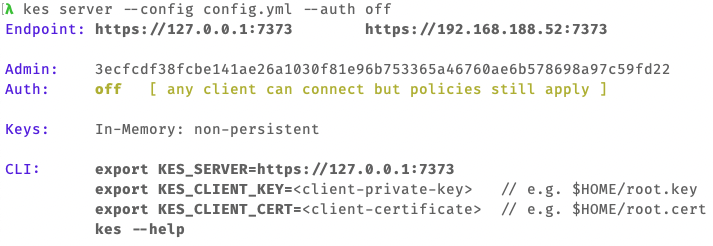-
Notifications
You must be signed in to change notification settings - Fork 98
Getting Started
This is the Getting Started guide. Here we show how to setup a local KES server that stores keys in-memory. Therefore, all keys will be gone once the KES server has been shut down.
╔══════════════════════════════════════════╗
┌────────────┐ ║ ┌────────────┐ ┌───────────┐ ║
│ KES Client ├─────╫───┤ KES Server ├──────────┤ In-Memory │ ║
└────────────┘ ║ └────────────┘ └───────────┘ ║
╚══════════════════════════════════════════╝
If you haven't installed KES yet, install it first.
A KES server can only be run with TLS - since secure-by-default. Here we use self-signed certificates for simplicity.
The following command will generate a new TLS private key server.key and
a X.509 certificate server.cert that is self-signed and issued for the IP 127.0.0.1
and DNS name localhost (as SAN). You may want to customize the command to match your
setup.
kes tool identity new --server --key server.key --cert server.cert --ip "127.0.0.1" --dns localhostAny other tooling for X.509 certificate generation works as well. For example, you could use
openssl:$ openssl ecparam -genkey -name prime256v1 | openssl ec -out server.key $ openssl req -new -x509 -days 30 -key server.key -out server.cert \ -subj "/C=/ST=/L=/O=/CN=localhost" -addext "subjectAltName = IP:127.0.0.1"
As the root identity we can perform any operation without having to worry about policies for now. A new identity can be created via:
kes tool identity new --key=root.key --cert=root.cert rootNow, switch to a new terminal window and start the KES server:
kes server \
--key=server.key \
--cert=server.cert \
--root=$(kes tool identity of root.cert) \
--auth=off
--auth=offis required since our root.cert certificates is self-signed

Now, we try to connect to the KES server, create a new secret key, derive a new data key and then decrypt the data key ciphertext.
Switch back to the previous terminal window to set the following environment variables:
export KES_CLIENT_KEY=root.key
export KES_CLIENT_CERT=root.cert
kes key create -k my-key
We have to specify
-ksince we use self-signed certificates.
kes key derive -k my-key
You will see some output similar to:
{
plaintext : ...
ciphertext: ...
}
The plaintext is a base64-encoded 256-bit key.
The ciphertext is the plaintext key encrypted with my-key at the server.
kes key decrypt -k my-key <base64-ciphertext>
For more CLI commands see: kes --help
Usage:
kes [options] <command>
Commands:
server Starts a KES server.
key Manage secret keys.
log Work with server logs.
policy Manage the kes server policies.
identity Assign policies to identities.
tool Run specific key and identity management tools.
Options:
-v, --version Print version information
-h, --help Show this list of command line options.